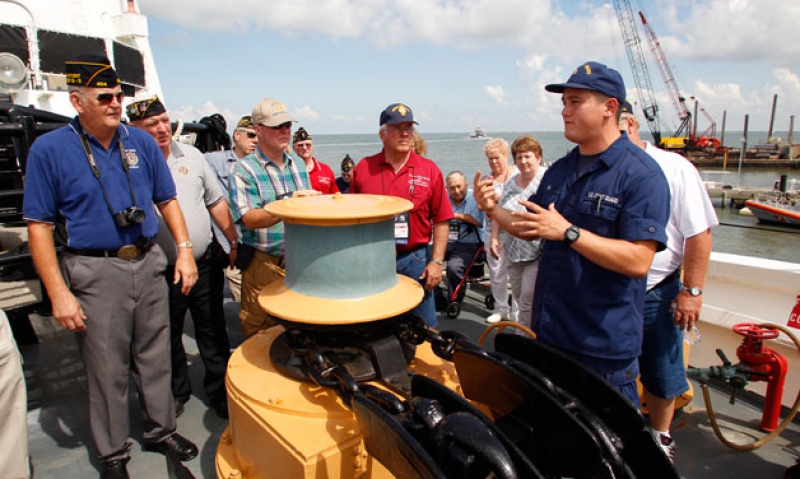
Legionnaires tour Coast Guard’s frontlines
Ships, boats and helicopters of the U.S. Coast Guard were the centers of attention during an Aug. 23 visit by members of The American Legion to the U.S. Coast Guard Command Sector Houston-Galveston and the U.S. Coast Guard Air Station Houston.
The Coast Guard station in Galveston is responsible for homeland security, good order and predictability of marine traffic within its designated Vessel Traffic Service Area along the 53-mile Houston Ship Channel.
About 80 members of The American Legion’s National Security Commission and guests got a tour of the station and a visit on board the U.S. Coast Guard Cutter Dauntless (WMEC 624). The 210-foot medium endurance cutter is manned by 80 crew members and officers; it was commissioned in 1967 and received a major overhaul in the 1990s.
The Dauntless has compiled an impressive record in its 46-year history. In fact, it became the first cutter in Coast Guard history to seize more than one million pounds of marijuana. This major accomplishment is signified by a large, gold marijuana leaf painted on the ship’s superstructure. To date, the Dauntless has 90 illegal narcotics “busts” to its credit – more than any other ship in the Coast Guard.
“Collectively, we were very impressed with both the professionalism and the dedication across the board, from E3 (seaman first class) to O6 (captain),” said Michael Schlee, chairman of the Legion’s National Security Commission. “They certainly knew their mission, they clearly enjoyed what they were doing.”
Schlee said it was a very fulfilling experience to see young men and women with such a high level of enthusiasm in support of America’s defense.
The Dauntless has also played a leading role in search and rescue operations, going back to the massive exodus of Cubans in 1980. Between April 23 and May 13 of that year, the Dauntless towed more than 25 vessels to safety, rescued eight people adrift on the Gulf of Mexico, and conducted 55 search-and-rescue missions.
At U.S. Coast Guard Air Station Houston at Ellington Air Force Base, Legionnaires were briefed by pilots and crew on the search-and-rescue capabilities of the MH-65 Dolphin helicopters stationed there. Each helicopter is crewed by a pilot, co-pilot, flight mechanic and search-and-rescue specialist.
One of the air station’s many responsibilities is to provide for the safety and security of 3,700 offshore oil platforms and the 35,000 people who work and live on them. However, the effects of automatic cuts to the country’s defense budget are being felt by the command.
Sequestration, Schlee said, is one of The American Legion’s continuing deep concerns. He spoke with one of the Coast Guard pilots, who told him the station’s flight hours have been reduced by 25 to 30 percent.
Schlee also spoke with crew members on the Dauntless. “Their cruising hours are down between 20 and 25 percent. So sequestration and the budget malaise that we’re facing in Washington is affecting units at the very basic operational level.” He said the Legion will continue to demand that Congress refrain from further defense budget cuts, and that its voice on this issue will “pop up a notch or two.”
The day after Legionnaires visited the air station, one of its MH-65 Dolphins conducted the medical evacuation of an individual from a chartered fishing boat 85 miles off Galveston. When a 33-year-old man began to experience stroke-like symptoms, the captain of the fishing boat Catch Hitter called in the Coast Guard. The air crew transferred the man to the University of Texas Medical Branch in stable condition.
“In this case, it’s a lucky break that the captain had a satellite phone on board and was able to contact us when his radio was out of range," said Petty Officer 3rd Class John Terrell, an operations specialist at Sector Houston-Galveston.
Schlee noted that the Coast Guard, due to its mixture of operational and humanitarian roles, “has the most diverse mission of any of the military services. And for 42,000 men and women strong – about the size of the New York City police department – we get a lot of bang for the buck.”
